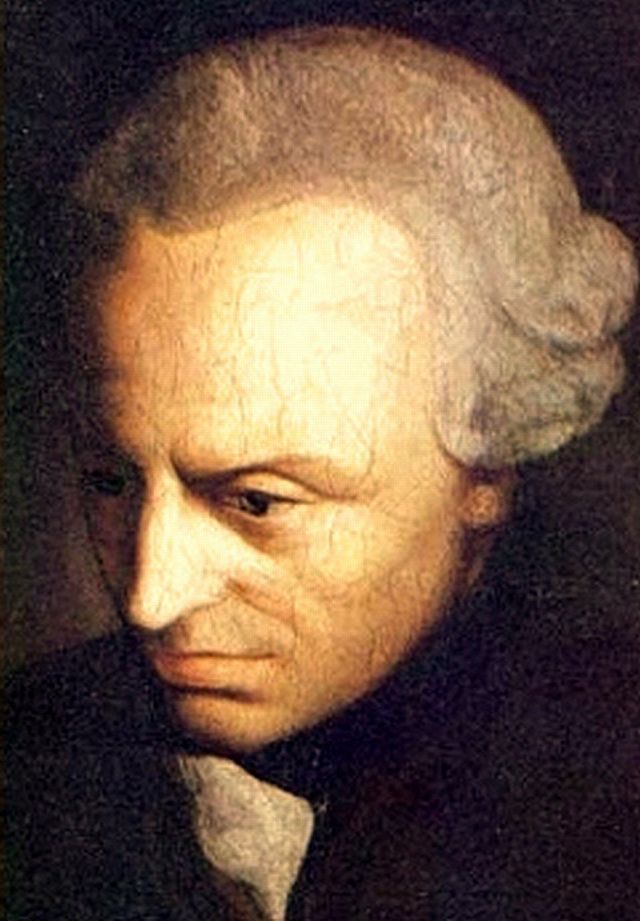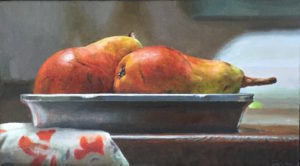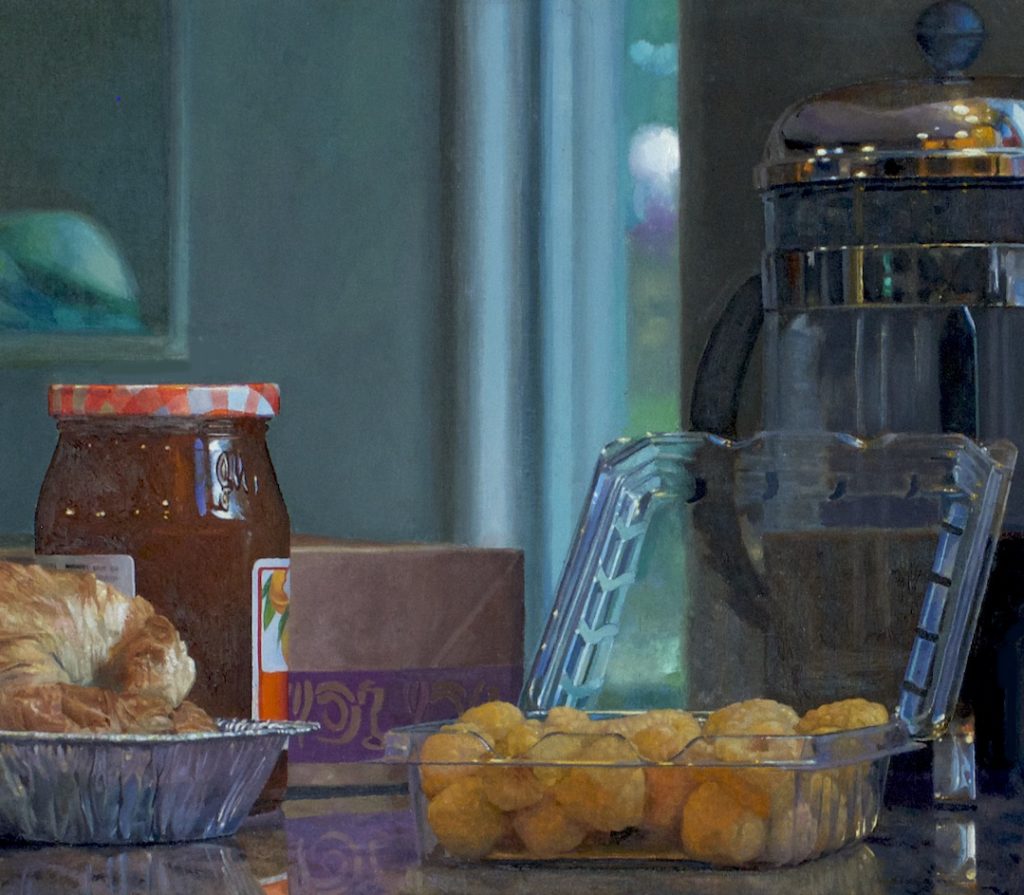The sublime and the beautiful revisited

Kant
In the The Sublime and the Beautiful Revisited, Iris Murdoch rexamines an aesthetic distinction that most people would associate with Edmund Burke—how what is beautiful and what is sublime occupy completely different modes of human experience. Her subject is Kant, though, and Kant presented Burke’s distinction in a slightly different way. For Kant, art creates a beautiful object, worthy in and of itself. A painting doesn’t instruct, or serve any purpose at all, but is a self-justifying object where human imagination and understanding come together in harmony. A work of art, by definition, has to be entirely intelligible, in this view—or, rather, its value resides in its intelligibility, even though it has nothing specific to say. It just is, and that’s enough, the way things in the world are what they are and are nothing else—and you recognize and appreciate it immediately for what it is, as you would a flower or a vase. It is what it is, transparently beautiful, and that’s quite enough. Kant isn’t interested in what doesn’t surrender to reason—reason equals freedom equals virtue. Moral choice for him was the exercise of reason, cutting through the murk and mess of individual human experience and emotion, facing toward what was universal and just plain reasonable, so that the individual could act on that knowledge. Beauty, in art, is the experience of seeing a hint of this order, this understanding, shine forth from something created.
With the sublime on the other hand, Kant follows Burke’s earlier distinction: it is an experience of the tension between reason and what’s beyond its grasp, the threatening mystery and magnitude of nature. In that confrontation between understanding and what resists reason, intransigent and hostile and overpowering, there was a thrill in which a human being feels gratified at being free of that threat, of being guided by the “dignity of reason” in the face of the inaccessible and inhuman snow-covered Alpine peak. Half a century later Melville felt only dread, even horror, at the whiteness of the whale—inscrutable, blank, pitiless, and alien. (That shift, the rise of dread and despair, in Melville and Kierkegaard and Nietzsche–and I suppose you could go on indefinitely with other figures, Munch and the expressionists and so on—would seem the most significant development in 19th century culture, emptying out into the angst and nausea of the existentialists.) Kant would have smiled with bemusement at Melville’s anxiety: Herman! Buddy! You’re troubled by the color white, sailor? Really? A color? For Kant, humanity transcends nature because we can establish and affirm what is intelligible and therefore superior to the opacity of the natural world, and thus exercise our freedom from it and give it meaning—which sounds very much like an apology for what we are now doing in science and technology and nearly everywhere else in our postmodern realm. We’re remodeling the unsatisfactory natural world, to our liking, along with human nature itself, as the genetic code becomes our sandbox. Good luck with that.
Murdoch takes Kant’s idea of the sublime, though, and brings it down to earth—what replaces the implacable and opaque in nature becomes, for Murdoch, the other human being. The woman in the seat next to you on the flight is just as stubbornly resistant to human will, and just as confounding to one’s solitary comfort as the vast silence of the starry sky. And yet with the passenger staking her claim to both armrests in 13A, you have a choice to make: you can tolerate and understand her or you can hate her. There’s no avoiding her, unfortunately. Loving her is probably out of the question, unless it’s a flight from New York to Sydney and the conversation takes a novel turn. By contrast, the Alps don’t care how you feel about them. She takes Kant’s acknowledgement of the way in which the world resists understanding and turns it into a certain kind of attention and the moral choice that can flow from it. For her—her essay was published in 1959—what Kant saw in the individual’s uneasy relationship with nature’s power transfers directly into what’s missing in contemporary art, especially fiction. For her, most fiction, and by implication other art forms, avoids this uneasy apprehension inherent in Kant’s notion of the sublime when applied to other people. What gets written is either a self-absorbed elaboration of the author’s own experience or obsessions—stripped down into mythic form—The Stranger or The Catcher in the Rye—or else it’s a thin journalistic/political account of contemporary life, full of verisimilitude, with characters that serve whatever predetermined purpose the novelist has in mind for them. Given that choice, she prefers, say, the pointlessness of The Catcher in the Rye. Yet, for her, the greatest novelists, such as Tolstoy, created a world populated by characters whose reality vastly exceeded whatever purpose they could have served for the writer—they demonstrated that the author succeeded in the heroic effort to forget himself by imagining, making real, other human beings completely distinct from the author’s personality. Their reality was the achievement, not anything the author wanted to say by making them real. And this is the heart of Murdoch’s entire philosophy: a human being’s greatest progress in realizing what is good comes as a consequence of being intensely aware of anything other than the self, but best of all, other human beings. That effortful awareness makes love possible. And one of the ways this love can manifest itself is by creating art—the most powerfully moral form of art being fiction. Updike criticized J.D. Salinger for loving his characters more than God loves them, but Murdoch would say there is no such thing as loving one’s fictional creations too much, as long as they aren’t just your avatars.
For her, George Eliot and Tolstoy and Jane Austen, were the masters of this self-effacement—Shakespeare even more so, as a playwright. She moves back and forth between philosophy and fiction/art, pointing out that you can find the same dichotomy among the philosophers, like Sartre and even Kierkegaard, on one side—the spiritually solipsistic freedom of the individual wrestling with God or just the contingency of life—and the linguistic philosophers like G.E. Moore or Wittgenstein, who seem to simplify all agonized moral choice by ironing out the various meanings of the word “good” in ordinary human language. (Admirably she gets through the entire essay without ever quoting Sartre’s famous “hell is other people.”) Define your terms and the way becomes clear; simply figure out what the “good” means in any given usage of the word and then do it. She doesn’t put it that simplistically, but makes it sound just about that dry and lifeless and easy. To know what’s right will lead to doing it—that idea goes back to Socrates. For her, in this choice between what she recognized as the two dominant modes of philosophy, what got lost was the problem of other people, all of those beings who exist and have needs beyond the boundaries of the thinker’s head and whose behavior creates dilemmas that can’t be solved by thinking about them, or making choices, in isolation. And doing what’s right, even when you know it, is generally a challenge for nearly everyone. And this is precisely what was getting lost, in her view, in fiction—the necessity of getting to know people who are completely different from you and wrestling with the demands for attention they place upon you, demands for sympathy, for action. For Murdoch, the art of the novel peaked with George Eliot and Anna Karenina and then began to decline.
Hers is an intensely moral vision of life. So it’s no wonder that the person who is missing in all this—a novelist she so strenuously avoids mentioning—is Proust. In Proust it all comes together in a way she probably wasn’t able to acknowledge—mostly because in Proust, as in Heidegger (whom she didn’t grapple with until it was too late in her career), an explicit concern with morality is almost entirely absent. Proust improvised an astonishingly complex social world from his own experience while obsessively examining a kaleidoscope of subjective, finely-calibrated emotional experiences—a fractal vortex of internal states (mostly having to do with sexual jealousy) of mind and heart. For Camus, Proust was the best example of the ideal of the artist who refuses the intellectual/philosophical extremes—he explores the rain forest of his own inner life and the inner life of others without ever going so far as to become a surrealist, and he constructs a beehive of human beings around his narrator, who give the reader a sense of the real, actual, objective world, though his approach never becomes journalistic. He embraces a poetic and yet exhaustively observant Middle Way. His characters are probably the most complex creations in all of fiction since Hamlet. But there is no moral dimension to his world—Harold Bloom puts him almost in a class by himself in Western literature, linking him to the Hindu sages, having recognized some fundamental unity in the good and bad, life and death. He looks past it entirely and gives to his characters his dispassionate and tolerant and inexhaustible curiosity and delighted awe—as if each human being, no matter how depraved or perverse or silly and shallow or great and admirable, were equivalent to a work of art so fascinatingly intricate and integrated that to pass any sort of moral judgment on his or her behavior would overlook that character’s marvelous complexity. The rain of his rapt attention falls on each of them, the just and the unjust, in equal measure. In a way, Proust sees people with the same detached but avid delight that a collector of insects brings to his display case, and yet he’s anything but detached about human life—the slippery, fluctuating continuum of feeling and intuition are almost all that matter in his world. It’s his medium. What’s diminished in Proust isn’t just the moral dimension, but love which is more than erotic compulsion or emotional dependency. As Bloom points out, the only real love in the novel is evident mostly in the narrator’s relationship with his mother and grandmother. To say the least, his vision lacks a certain friendly warmth, and so I think Murdoch, whose philosophy is all but Christian—a sort of gospel of goodness and love without God—had to avoid grappling with this figure who did exactly what she required by creating a multitude of unpredictable, living human beings, each dramatically distinct and independent from the author himself. He has no designs on them, they are allowed to be simply what they are, the sprawling mess of their behavior seeping like colors of the rainbow throughout hundreds and hundreds of pages, free to do whatever they most naturally do, because the huge novel is orchestrated almost without a plot. The problem for her had to be that Proust didn’t recognize the significance of moral choice—we are what we are, and it’s a marvel, for better or worse. He was a mystic for whom paradise is everywhere, in all the minute particulars of the world around him—completely out of reach to his purposeful, everyday (and moral) mind, but present everywhere in the pages of his book. Proust’s creative relationship to the world is, for me, identical with a great painter’s who presents the world–his or her world–just as it is, for its own sake, without any agenda or purpose other than to make it alive and real.
 A detail of Summer Storm by Jean K. Stephens, one of many great paintings on view at
A detail of Summer Storm by Jean K. Stephens, one of many great paintings on view at 

